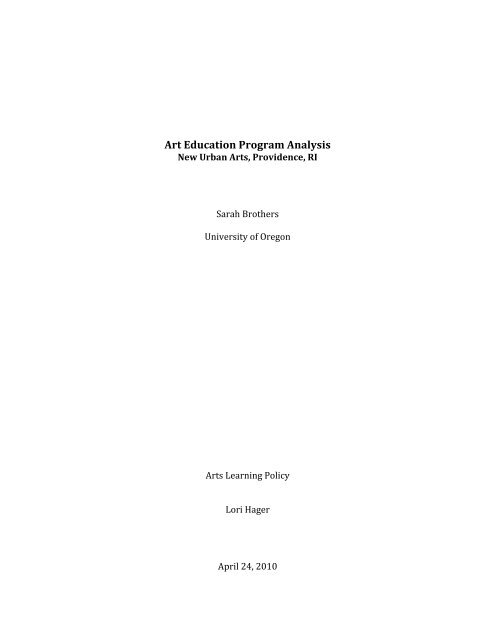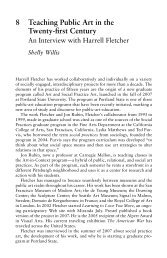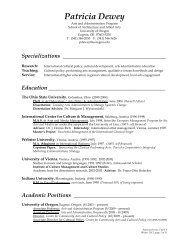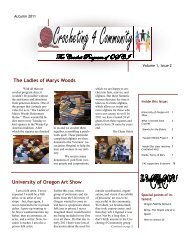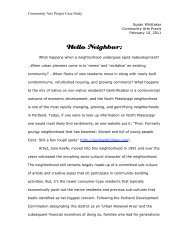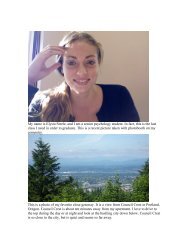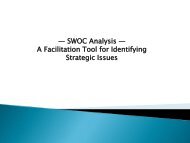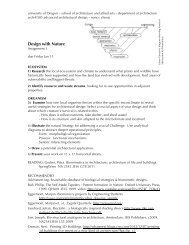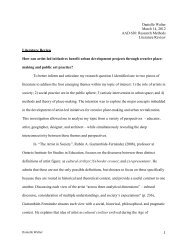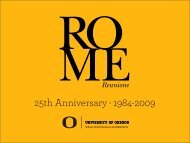Art Education Program Analysis - School of Architecture and Allied ...
Art Education Program Analysis - School of Architecture and Allied ...
Art Education Program Analysis - School of Architecture and Allied ...
Create successful ePaper yourself
Turn your PDF publications into a flip-book with our unique Google optimized e-Paper software.
<strong>Art</strong> <strong>Education</strong> <strong>Program</strong> <strong>Analysis</strong><br />
New Urban <strong>Art</strong>s, Providence, RI<br />
Sarah Brothers<br />
University <strong>of</strong> Oregon<br />
<strong>Art</strong>s Learning Policy<br />
Lori Hager<br />
April 24, 2010
New Urban <strong>Art</strong>s is a nationally recognized non‐pr<strong>of</strong>it community‐based<br />
organization located in Providence, Rhode Isl<strong>and</strong>, serving high school students <strong>and</strong><br />
emerging artists. Founded in 1997, they provide studio, exhibition space, <strong>and</strong><br />
mentoring for young artists who explore the visual, performing, <strong>and</strong> literary arts<br />
through year long free out‐<strong>of</strong>‐school programs.<br />
New Urban <strong>Art</strong>s has been recognized as one <strong>of</strong> the fifty premiere arts <strong>and</strong><br />
youth development programs in the country for the past five years. They have won<br />
local, state, <strong>and</strong> national awards for their work, including: the Jobez Gorham Award<br />
by the <strong>Art</strong>s <strong>and</strong> Business Council <strong>of</strong> Rhode Isl<strong>and</strong>, Champion in Action by Citizens<br />
Bank, the state’s best non‐pr<strong>of</strong>it in 2003 by Providence Phoenix, the Daedelus<br />
Award by Providence Waterfire, <strong>and</strong> the founding Executive Director, Tyler<br />
Denmead, was selected as the state’s best role model by Rhode Isl<strong>and</strong> Monthly. In<br />
2009, New Urban <strong>Art</strong>s was awarded the Coming Up Taller award by the President's<br />
Committee on the <strong>Art</strong>s <strong>and</strong> the Humanities ‐ the nation’s highest honor for the field<br />
<strong>of</strong> out‐<strong>of</strong>‐school time arts <strong>and</strong> humanities programs<br />
(http://www.newurbanarts.org).<br />
In this paper, I will discuss the characteristics <strong>of</strong> effective community‐based<br />
youth arts organizations as identified in various research reports, <strong>and</strong> connect them<br />
with the New Urban <strong>Art</strong>s practices according to the following criteria:<br />
organizational structure, educational programs, theories <strong>of</strong> learning, planning <strong>and</strong><br />
implementation process, teacher support/pr<strong>of</strong>essional development, partners,<br />
resources <strong>and</strong> sustainability, <strong>and</strong> assessment <strong>and</strong> outcomes.<br />
Mission:<br />
New Urban <strong>Art</strong>s’ mission is ‘to build a vital community that empowers young<br />
people to develop a creative practice they can sustain throughout their lives’<br />
(http://www.newurbanarts.org).<br />
Population Served:<br />
New Urban <strong>Art</strong>s has over 300 high school students register throughout the<br />
school year, which begins in September. Most youth learn are referred through
friends, but others are referred through guidance counselors, teachers, social<br />
workers, <strong>and</strong> parents. As a result <strong>of</strong> efforts to recruit underrepresented populations,<br />
students served are 28% are African‐American, 28% Latino, 22% Caucasian, 14%<br />
Southeast Asian, 3% Caribbean, <strong>and</strong> 5% bi‐racial. Their students equally represent<br />
ages between 14 <strong>and</strong> 18. Students come from 13 different schools in Providence,<br />
thought the majority come from the two neighboring high schools.<br />
In the Providence public school system, over 40% <strong>of</strong> students live in poverty. Only<br />
24% <strong>of</strong> Providence residents age 25 <strong>and</strong> over have earned a bachelor’s degree or<br />
higher, <strong>and</strong> 68% <strong>of</strong> families in Providence have an income below $50,000. Only one<br />
public high school in the city has an average combined SAT score above 825<br />
(http://www.newurbanarts.org).<br />
Organizational Structure:<br />
The organization is comprised <strong>of</strong> an executive director, program director,<br />
operations manager, development associate, studio manager, twenty‐one artist<br />
mentors, <strong>and</strong> two mentoring fellows. All <strong>of</strong> the staff are artists themselves, yet also<br />
have substantial working experience in education, youth development, <strong>and</strong> non‐<br />
pr<strong>of</strong>it management. All <strong>of</strong> the artist mentors are emerging artists, most <strong>of</strong> whom are<br />
current students or graduates <strong>of</strong> Rhode Isl<strong>and</strong> <strong>School</strong> <strong>of</strong> Design. There are eighteen<br />
members on the board (not counting the youth advisory members), <strong>and</strong> their<br />
experience ranges from pr<strong>of</strong>essional artists, to local educators from Brown<br />
University, politicians, <strong>and</strong> business leaders.<br />
<strong>Education</strong> <strong>Program</strong>s:<br />
There have been numerous studies done to determine the essential elements<br />
<strong>of</strong> successful youth arts programs. Key findings in Milbrey McLaughlin’s Community<br />
Counts, Adelma Roach’s Creating Cultural Policies With <strong>and</strong> For Young People, <strong>and</strong> in<br />
reports like Qualities <strong>of</strong> Quality <strong>and</strong> the Americans for the <strong>Art</strong>s Youth Toolkit all<br />
seem to be in unison, highlighting the same core types <strong>of</strong> programs <strong>and</strong> experiences<br />
for youth. All agree that successful programs provide a safe place for their youth
<strong>and</strong> recognize that art is a vehicle that can be used to engage them <strong>and</strong> increase<br />
their self‐esteem. They say that the delivery <strong>of</strong> the program is a collaborative effort<br />
among the artist, social service provider, teacher, agency staff, youth, <strong>and</strong> family.<br />
They emphasize dynamic teaching tactics such as h<strong>and</strong>s‐on learning, apprentice<br />
relationships, <strong>and</strong> the use <strong>of</strong> technology as well as providing youth with<br />
opportunities to succeed <strong>and</strong> take on leadership roles. They also state that programs<br />
should lead to a public performance or exhibition in an effort to build participants’<br />
self‐esteem through public recognition. Additionally, programs are designed with<br />
evaluation systems built in from the beginning to measure their intended outcomes.<br />
In A Report on CommunityBased Youth Organizations, Heath, Soep, <strong>and</strong> Roach<br />
(1998) state that effective youth arts organizations engage across the spectrum,<br />
including visual, movement, music, drama, <strong>and</strong> media, <strong>and</strong> emphasize the<br />
importance <strong>of</strong> community partnerships <strong>and</strong> events. McLaughlin puts it simply in<br />
Community Counts. She says the best programs are youth, knowledge, <strong>and</strong><br />
assessment centered.<br />
New Urban <strong>Art</strong>s programming exemplifies these practices with their six core<br />
components that provide education <strong>and</strong> pr<strong>of</strong>essional development for youth <strong>and</strong> for<br />
adult artist mentors. These programs are:<br />
1. Their Youth Mentorship <strong>Program</strong> partners <strong>Art</strong>ist Mentors with small<br />
groups <strong>of</strong> high school students for an entire year. They foster risk‐taking<br />
<strong>and</strong> self‐discovery through community building <strong>and</strong> creative arts projects<br />
designed collaboratively by both <strong>Art</strong>ist Mentors <strong>and</strong> youth.<br />
2. Their <strong>Art</strong>ist Mentor Pr<strong>of</strong>essional Development <strong>Program</strong> trains <strong>and</strong><br />
supports their <strong>Art</strong>ist Mentors each year. Topics include: youth<br />
development, community arts practice, nonpr<strong>of</strong>it management <strong>and</strong><br />
community‐building.<br />
3. Their Studio Team Advisory Board (STAB) is a collective <strong>of</strong> students<br />
<strong>and</strong> alumni who meet regularly <strong>and</strong> work to cultivate New Urban <strong>Art</strong>s as<br />
a youth‐driven studio. They advocate for youth voice; advise the staff <strong>and</strong><br />
board <strong>of</strong> directors; represent the organization to community leaders <strong>and</strong><br />
supporters; assist in the recruitment <strong>and</strong> orientation <strong>of</strong> new students;<br />
annually interview <strong>and</strong> selecting artist mentors; organize exhibits, events,<br />
publications <strong>and</strong> arts workshops for the public.<br />
4. Their Summer <strong>Art</strong> Inquiry is a thematic‐based arts inquiry program in<br />
which artists, scholars <strong>and</strong> high school students spend the summer<br />
exploring a common theme from a from a multi‐disciplinary st<strong>and</strong>point<br />
including research, art‐making, creative writing <strong>and</strong> personal inquiry.
The program culminates in student‐led public workshops <strong>and</strong> an<br />
exhibition. Students receive stipends for their participation <strong>and</strong> acquire<br />
in‐depth thematic knowledge <strong>and</strong> job‐readiness skills.<br />
5. Their <strong>Art</strong>s Mentoring Fellowship supports two established artists <strong>and</strong><br />
educators for an entire year. Fellows publicly share knowledge, ideas <strong>and</strong><br />
artwork about community arts practice <strong>and</strong> convene public conversations<br />
on sustaining lifelong creative practice. In the tradition <strong>of</strong> collegiate<br />
pr<strong>of</strong>essors, Fellows attend regular studio hours each week for artist<br />
mentors to seek immediate feedback through direct, one‐on‐one<br />
consultation, supporting the pr<strong>of</strong>essional development <strong>of</strong> <strong>Art</strong>ist Mentors.<br />
6. New Urban <strong>Art</strong>s also provides the opportunity for students to exhibit,<br />
perform, <strong>and</strong> publish throughout the year. New Urban <strong>Art</strong>s has an<br />
annual fashion show in which students model clothing designed <strong>and</strong><br />
sewn by other students, poetry readings at two art openings, two student<br />
art exhibits, a student‐produced zine publication that features their<br />
artwork, <strong>and</strong> an annual compilation <strong>of</strong> student poetry. Gallery exhibitions<br />
incorporate wall text to share artist statements, program impact, <strong>and</strong><br />
reflection.<br />
Theories <strong>of</strong> Learning (Impact):<br />
New Urban <strong>Art</strong>s practice is guided by the following values: connection, voice,<br />
risk, inclusion, <strong>and</strong> leadership. These are the core themes discussed in A Report on<br />
CommunityBased Youth Organizations, by Heath, Soep, <strong>and</strong> Roach (1998). New<br />
Urban <strong>Art</strong>s believes that everyone needs a mentor – someone to trust, to share<br />
honesty with, <strong>and</strong> enable us to be accountable to ourselves. That everyone needs a<br />
safe space to be themselves, to have their own ideas <strong>and</strong> vision. They see the arts as<br />
a way to help connect individuals. They believe in diverse voice where individuals<br />
can learn from one another, <strong>and</strong> in including everyone. They believe that risk <strong>and</strong><br />
challenge are necessary for growth. And they are committed to providing<br />
opportunities for leadership roles.<br />
Planning <strong>and</strong> Implementation Process:<br />
In the Americans for the <strong>Art</strong>s Youth Toolkit, it is suggested that when planning a<br />
program, staff must clearly define the goals <strong>and</strong> intended outcomes, <strong>and</strong> monitor,<br />
document, <strong>and</strong> evaluate the program implementation <strong>and</strong> service‐delivery process,<br />
as well as the impact. They also say that there are five basic steps in developing a<br />
planning model:
1. Identify the conditions, or needs to address <strong>and</strong> write a problem statement<br />
about them.<br />
2. State what is intended to change, in the long run, about those conditions.<br />
These long‐term changes will be the expected impacts <strong>of</strong> the program.<br />
3. Describe how to achieve these long‐term changes <strong>and</strong> describe the program<br />
activities to be implemented. (Selection <strong>of</strong> a specific program approach<br />
should be based on research, experience, <strong>and</strong>/or sound theory.)<br />
4. Specify what short‐term changes, or immediate <strong>and</strong> intermediate outcomes,<br />
will occur as a result <strong>of</strong> program activities <strong>and</strong> how they will ultimately lead<br />
to the long‐term impacts identified.<br />
5. Review the results <strong>of</strong> the previous steps.<br />
New Urban <strong>Art</strong>s Bases its programming the premise <strong>of</strong> the following questions,<br />
continuously reflecting on their practices <strong>and</strong> seeking to improve their performance<br />
<strong>and</strong> impact:<br />
• What resources, skills, <strong>and</strong> opportunities do young people need today so that<br />
they will make space throughout their lives for creative thought <strong>and</strong><br />
expression?<br />
• What is an ideal level <strong>of</strong> participation for students to work towards this goal?<br />
• How diverse is our student body <strong>and</strong> is this diversity reflected throughout<br />
various participation levels?<br />
• How can artist mentors become more effective in engaging students in<br />
learning <strong>and</strong> deepening their artistic practice?<br />
• To what extent is New Urban <strong>Art</strong>s an inclusive environment that encourages<br />
students to work toward our learning outcomes?<br />
• In what ways do students develop self‐initiative through participation in our<br />
program?<br />
• In what ways do students strengthen their ability to build trusting <strong>and</strong> caring<br />
relationships with others?<br />
• In what ways do students deepen their creative practice through<br />
participation in our program?<br />
• In what ways do students deepen their creative practice through<br />
participation in our program? (http://www.newurbanarts.org).<br />
Teacher Supports/Pr<strong>of</strong>essional Development:<br />
According to Americans for the <strong>Art</strong>s Youth Toolkit, all those that work with youth<br />
should be providing with training in team building, communication skills,<br />
organization skills, effective methods for working with youth from specific<br />
populations, behavior management, <strong>and</strong> curriculum development. Trainings should<br />
be done in groups so that staff <strong>and</strong> mentors can learn from one‐another <strong>and</strong> get to
know each other’s perspectives, successes <strong>and</strong> failures, <strong>and</strong> ways <strong>of</strong> working.<br />
Training should be implemented ongoing throughout the season.<br />
As I mentioned earlier, New Urban <strong>Art</strong>s provides <strong>Art</strong>ist Mentor Pr<strong>of</strong>essional<br />
Development trainings <strong>and</strong> supports their <strong>Art</strong>ist Mentors each year. Topics for<br />
trainings include: youth development, community arts practice, nonpr<strong>of</strong>it<br />
management <strong>and</strong> community‐building. New Urban <strong>Art</strong>s staff lead workshops for<br />
their mentors in monthly meetings, all‐day retreats, weekly small‐group meetings<br />
<strong>and</strong> one‐to‐one coaching. The program is also supplemented with presentations by<br />
guest artists, educators, <strong>and</strong> diverse community leaders.<br />
Partners:<br />
In Beyond Enrichment, Remer (1996) describes the seven ‘Cs’ for Creative<br />
Connections as: construction, communication, context, constraints, critique,<br />
commitment, <strong>and</strong> counselor. She adds an eighth: catalyst, as well.<br />
Although, I was unable to find any information specific to the partnerships<br />
New Urban <strong>Art</strong>s has developed, it is clear in reviewing their programs that they play<br />
an active role in the community, providing information, resources, trainings <strong>and</strong><br />
community development projects on an on‐going basis, <strong>and</strong> they communicate with<br />
local schools, leaders, <strong>and</strong> businesses.<br />
Resources <strong>and</strong> Sustainability:<br />
Aside from being a very successful community arts organization for over 13<br />
years, with local, state, <strong>and</strong> national recognition, New Urban <strong>Art</strong>s has great<br />
community support. Due to the creative nature <strong>of</strong> the city <strong>of</strong> Providence, Rhode<br />
Isl<strong>and</strong>, <strong>and</strong> the presence <strong>of</strong> Rhode Isl<strong>and</strong> <strong>School</strong> <strong>of</strong> Design, the community is an<br />
enormous resource for New Urban <strong>Art</strong>s. They have no problem finding young,<br />
emerging artists, eager to gain skills in youth development <strong>and</strong> education to<br />
volunteer as <strong>Art</strong>ist Mentors. There are also several other prestigious schools <strong>and</strong><br />
successful businesses near by to support the organization’s efforts. Additionally,<br />
they are located conveniently across the street from two high schools, making youth<br />
recruitment efforts <strong>and</strong> collaborations easier.
New Urban <strong>Art</strong>s have a state <strong>of</strong> the arts gallery space <strong>and</strong> studio, equip with<br />
cameras, video cameras, a black <strong>and</strong> white darkroom, a digital media center, silk<br />
screening <strong>and</strong> other printmaking facilities, resources for fashion design, as well as<br />
materials to support painting, drawing, installation art, <strong>and</strong> creative writing.<br />
According to Heath, Soep, <strong>and</strong> Roach, in order to sustain interest <strong>of</strong><br />
participants, a level <strong>of</strong> risk within a safe place is necessary. Risk, being one <strong>of</strong> the<br />
core values <strong>of</strong> New Urban <strong>Art</strong>s, the ever‐evolving programs <strong>and</strong> maintained interest<br />
by its youth participants has being accomplished.<br />
Assessment <strong>and</strong> Outcomes:<br />
In order to evaluate their program <strong>and</strong> determine their impact, New Urban <strong>Art</strong>s<br />
uses the following measurement/assessment tools:<br />
• Student registration system to measure the diversity <strong>of</strong> our student body;<br />
• Participation tracking system to measure the duration <strong>and</strong> frequency <strong>of</strong><br />
participation;<br />
• Portfolios <strong>and</strong> exit interviews for artist mentors to measure our ability to<br />
engage students in learning <strong>and</strong> deepening their creative practice;<br />
• Portfolios for students to measure the extent to which they deepen their<br />
creative practice;<br />
• Exit interviews for students to measure our ability to build an inclusive,<br />
stimulating learning environment;<br />
• A retroactive post survey for parents to measure our parent engagement<br />
strategies, as well as the impact in their children that they can feel be<br />
attributed to our program;<br />
• A pre <strong>and</strong> post survey to measure students progress toward our 3 learning<br />
outcomes (self‐initiative, social relationships, creative practice), as well as<br />
the extent to which New Urban <strong>Art</strong>s builds an inclusive, stimulating<br />
environment, <strong>and</strong> have effectively trained <strong>and</strong> supported mentors that<br />
engage them in learning.<br />
• Case studies in which the <strong>Program</strong> Director draws on information for all<br />
graduating seniors from their portfolios, exit interviews, the creative practice<br />
rubric, <strong>and</strong> written reflection tools to present the development <strong>of</strong> students<br />
over a multi‐year period (http://www.newurbanarts.org).<br />
In addition to utilizing measurement tools, New Urban <strong>Art</strong>s has published<br />
several reports on their findings, including A Sustainable Creative Practice, by the<br />
founder, Tyler Denmead in 2006, <strong>and</strong> a Poetry Workshop Planning Guide in 2005.
It is clear that New Urban <strong>Art</strong>s is a model program for providing youth with<br />
opportunities for arts learning, meaningful relationships, <strong>and</strong> opportunities to build<br />
skills for life. They are committed to sharing their innovative practice, while<br />
remaining open to the challenge <strong>of</strong> adapting <strong>and</strong> evolving.
References<br />
Fiske, Edward B. ( Ed.). (?) Champions <strong>of</strong> Change: The Impact <strong>of</strong> the <strong>Art</strong>s on<br />
Learning.<br />
Heath, S. B., Soep, E., & Roach, A. (1998) Living the <strong>Art</strong>s Through Language Learning:<br />
A Report on Community‐Based Youth Organizations. The <strong>Art</strong>s Monographs.<br />
2(7).<br />
McLaughlin, Milbrey. (?) Community Counts. Retrieved from<br />
www.Public<strong>Education</strong>.org<br />
http://www.newurbanarts.org<br />
Remer, Jane. (1996) Beyond Enrichment: Building Effective <strong>Art</strong>s Partnerships with<br />
<strong>School</strong>s <strong>and</strong> Your Community. New York: American Council for the <strong>Art</strong>s Books.<br />
Roach, Adelma. (2000). Creating Cultural Policies With <strong>and</strong> For Young People.<br />
Cultural Policy in the West II conducted at the meeting <strong>of</strong> the Aspen Institute,<br />
Aspen, Colorado.<br />
Seidel, S., Tishmen, S., Winner, E., Hetl<strong>and</strong>, L., & Palmer, P. (2009) The Qualities <strong>of</strong><br />
Quality: Underst<strong>and</strong>ing Excellence in <strong>Art</strong>s <strong>Education</strong>. Caimbridge: Project Zero,<br />
Harvard Graduate <strong>School</strong> <strong>of</strong> <strong>Education</strong>.<br />
America For the <strong>Art</strong>s, Youth<strong>Art</strong>s Toolkit. Retrieved from<br />
http://www.americansforthearts.org/youtharts/bestpractices.asp


